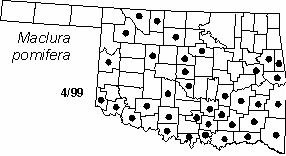Tree to 12 m (40 ft) tall and 50 cm (20 in) diameter, often with a short thick trunk and numerous low branches. Bark gray to yellow-brown, thick, divided into narrow forking ridges. Twigs thick, brown, becoming glabrous, usually with hard sharp spines to 2.5 cm (1 in) long at leaf bases. Buds small, round, light brown, no terminal bud. Sap thick, white, sticky. Leaves alternate, ovate, 6-12 cm (2.4-4.8 in) long and 4-7 cm (1.6-2.8 in) wide, usually acuminate, entire, glabrous, shiny dark green above, pale green below. Flowers staminate and pistillate on different trees, very small, green, blooming in early Spring. Staminate flowers in a cylindrical cluster about 4 cm (1.6 in) long. Pistillate flowers in a spherical cluster about 2.5 cm ( 1 in) in diameter. Fruits tightly aggregated into large yellow-green balls to about 12 cm (5 in) diameter.
Distribution: The species has been widely planted and has become naturalized over much of the U. S. except for the coldest and driest regions. The presettlement distribution is thought to have been from central Oklahoma down the Arkansas and Red Rivers to the lower Mississippi valley.
Habitat: Floodplain forests, old fields, fencerows.
NWI status: UPL
Comment: The Osages used the wood for bows, resulting in the French name "bois d'arc". Before barbed wire came into general use, hedge apple was widely used as a spiny living fence to keep cattle out of crops. The wood is very resistant to decay, and is used for fence posts. The wood and bark have been used in the past for tanning and dyeing. Maclura honors early American geologist William Maclure; pomifera means "fruit-bearing" and refers to the large conspicuous aggregations of fruits.
Distribution in Oklahoma: 
BACK
NEXT
RETURN TO INDEX
Last update: 9/14/99
 Go to Oklahoma Biological Survey Home Page
Go to Oklahoma Biological Survey Home Page
 Disclaimer
Disclaimer